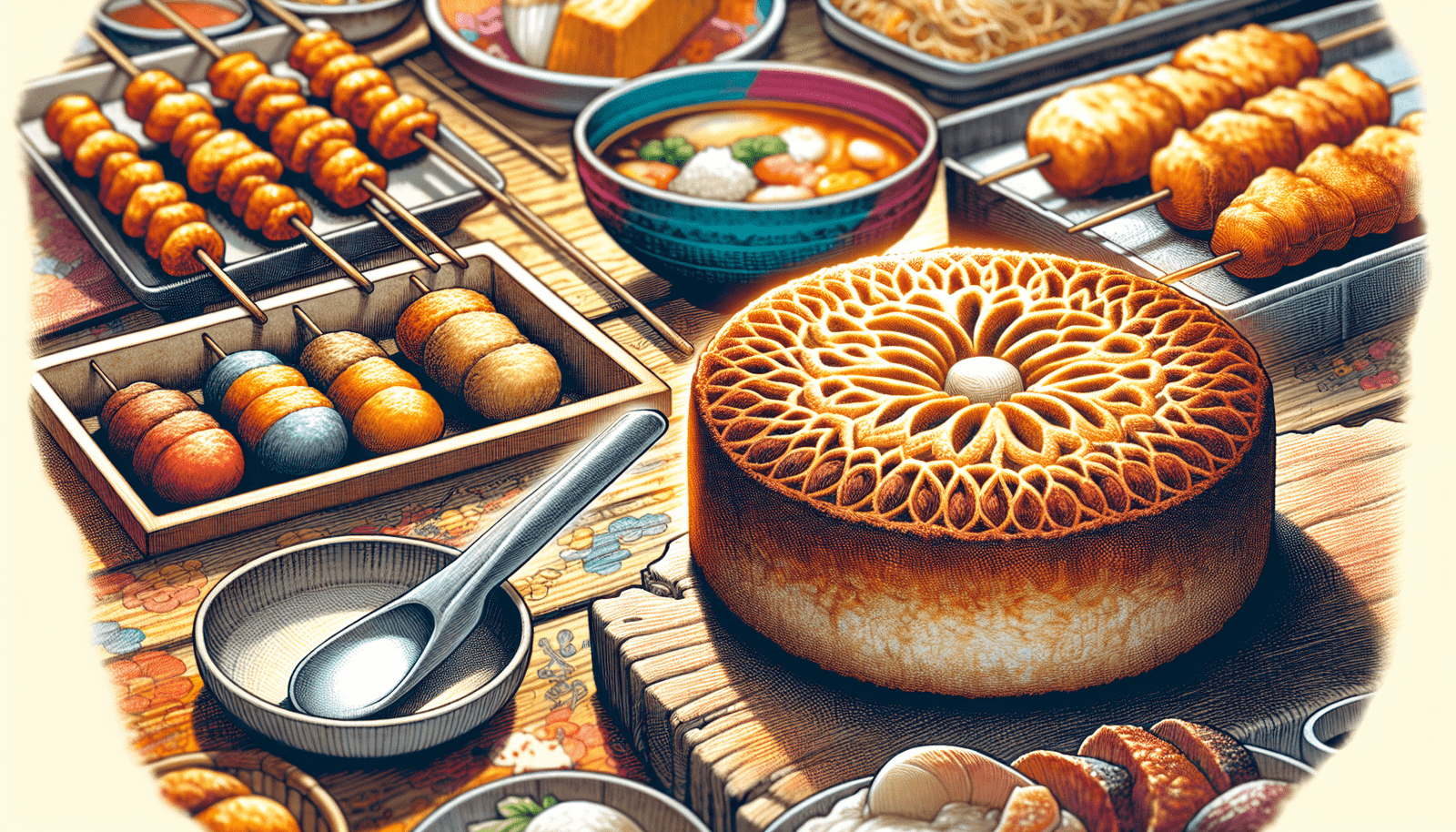Step into the fascinating world of traditional Korean cuisine and discover the intricate process of making and incorporating eomuk, or the beloved Korean fish cake, into a variety of mouthwatering dishes. From street food favorites to hearty soups and stews, this article will take you on a culinary journey through the rich history and diverse flavors of eomuk. Whether you’re a connoisseur of Korean cuisine or simply curious about global gastronomy, prepare to be captivated by the incredible versatility and delectable taste of this iconic Korean delicacy. Get ready to tantalize your taste buds and expand your culinary horizons with the story behind traditional Korean fish cake.
Traditional Korean Fish Cake (Eomuk) Preparation
Ingredients for Making Traditional Korean Fish Cake
To make traditional Korean fish cake, you will need the following ingredients:
- Fresh white fish fillets (like cod or pollack)
- Potato starch or sweet potato starch
- Onion, grated
- Garlic, minced
- Salt
- Ground black pepper
- Soy sauce
- Sugar
- Vegetable oil
- Water
Steps for Making Traditional Korean Fish Cake
- Start by cleaning the fish fillets and removing any bones.
- Cut the fish into small pieces and place them in a food processor.
- Blend the fish until it turns into a smooth paste.
- Transfer the fish paste to a mixing bowl and add grated onion, minced garlic, salt, ground black pepper, soy sauce, and sugar.
- Mix everything together until well combined.
- Gradually add potato starch or sweet potato starch to the mixture, mixing well after each addition, until the dough becomes thick and sticky.
- Fill a large pot with water and bring it to a boil.
- Wet your hands and shape the fish cake dough into thin rectangular slices or desired shapes.
- Carefully drop the fish cake slices into the boiling water and cook for about 3-4 minutes, or until they float to the surface.
- Remove the cooked fish cakes from the water and set them aside to cool.
- Once cooled, you can use the fish cakes immediately in various dishes or store them in the refrigerator for later use.
Variations of Traditional Korean Fish Cake
Steamed Fish Cake (Mandu)
Steamed fish cake, also known as “mandu,” is a delicious variation of traditional Korean fish cake. To make this dish, simply steam the fish cakes until they become soft and tender. Steamed fish cake is often enjoyed as an appetizer or served as a side dish with dipping sauce.
Fried Fish Cake (Twigim)
If you prefer a crispy and flavorful fish cake, try making fried fish cake or “twigim.” To prepare this variation, heat vegetable oil in a frying pan and fry the fish cakes until they turn golden brown and crispy. Fried fish cake is popular as a street food snack or served as a side dish with a meal.
Fish Cake Soup (Eomukguk)
Fish cake soup, or “eomukguk,” is a comforting and hearty dish made with traditional Korean fish cake. To make the soup, simmer the fish cakes in a flavorful broth along with vegetables such as radish, onion, and green onions. Fish cake soup is often enjoyed as a meal on its own or served with rice and other side dishes.

Traditional Korean Fish Cake in Street Food
Eomuk Skewers
Eomuk skewers are a popular street food in Korea. The fish cakes are skewered and grilled over charcoal, giving them a smoky and delicious flavor. Eomuk skewers can be enjoyed plain or brushed with a savory sauce for added taste.
Eomuk Hot Pot
Eomuk hot pot, or “eomuk jeongol,” is a popular Korean dish that features traditional fish cake cooked in a hot pot with various other ingredients such as vegetables, tofu, and noodles. The hot pot is simmered in a flavorful broth, allowing the fish cake to absorb all the delicious flavors.
Traditional Korean Fish Cake in Soups and Sews
Tteokbokki (Spicy Rice Cake) with Fish Cake
Tteokbokki is a beloved Korean dish made with chewy rice cakes cooked in a spicy sauce. Adding traditional fish cake to the tteokbokki gives it a delightful texture and enhances the overall flavor. This dish is commonly enjoyed as a street food snack or a main course.
Kimchi Jjigae (Kimchi Stew) with Fish Cake
Kimchi jjigae is a popular Korean stew known for its spicy and tangy flavors. Traditional fish cake adds a unique taste and chewy texture to the kimchi stew. The combination of the fish cake with the kimchi and other ingredients creates a delicious and satisfying meal.

Traditional Korean Fish Cake in Rice Dishes
Bibimbap (Mixed Rice) with Fish Cake
Bibimbap is a classic Korean rice dish that features various sautéed vegetables, meat, and a fried egg served over a bed of steamed rice. Adding traditional fish cake to bibimbap adds an extra layer of flavor and texture. It’s a delicious way to enjoy the fish cake in a well-balanced and nutritious meal.
Gimbap (Seaweed Rice Roll) with Fish Cake
Gimbap is a popular Korean snack or light meal made by rolling steamed rice, vegetables, meat, and fish cake in a sheet of seaweed. The addition of traditional fish cake to gimbap provides a savory and chewy element to this tasty and portable dish.
Traditional Korean Fish Cake in Noodles
Japchae (Stir-fried Glass Noodles) with Fish Cake
Japchae is a Korean noodle dish made with sweet potato glass noodles stir-fried with an assortment of vegetables and meat. Traditional fish cake can be added to japchae to enhance the dish’s texture and flavor. The combination of the chewy noodles, crunchy vegetables, and tender fish cake makes for a satisfying meal.
Rabokki (Ramen and Tteokbokki) with Fish Cake
Rabokki is a fusion dish that combines two beloved Korean dishes: ramen and tteokbokki. This spicy and comforting dish features traditional fish cake along with chewy rice cakes, ramen noodles, and a savory sauce. The fish cake adds a delightful chewiness to the dish, making it a favorite among street food enthusiasts.

Traditional Korean Fish Cake as Snacks
Fish Cake Fritters
Fish cake fritters are a delicious and crispy snack made by deep-frying bite-sized pieces of traditional fish cake. These fritters can be enjoyed on their own or served with a dipping sauce for an extra burst of flavor. They make for a perfect snack to satisfy your cravings.
Fish Cake Skewers with Dipping Sauce
Fish cake skewers are not only popular street food but also make for a fun and tasty snack. Skewer small pieces of traditional fish cake and serve them with a variety of dipping sauces such as spicy gochujang sauce or tangy soy sauce. These skewers are a crowd-pleasing snack for any occasion.
Traditional Korean Fish Cake in Pancakes
Haemul Pajeon (Seafood Pancake) with Fish Cake
Pajeon is a savory pancake made with various ingredients such as seafood, green onions, and vegetables. Adding traditional fish cake to the pajeon enhances its taste and adds a chewy texture. Haemul pajeon with fish cake is a popular Korean appetizer or side dish, perfect for sharing with friends and family.
Buchimgae (Korean Pancake) with Fish Cake
Buchimgae is a versatile Korean pancake that can be made with a variety of ingredients, including traditional fish cake. The fish cake adds a unique flavor and texture to the pancake, making it a delicious and satisfying dish. Buchimgae with fish cake can be enjoyed as a snack or served as a side dish with a meal.

Traditional Korean Fish Cake in Banchan (Side Dishes)
Eomuk Bokkeum (Stir-fried Fish Cake)
Eomuk bokkeum is a quick and easy side dish made by stir-frying traditional fish cake with vegetables and a savory sauce. This delicious banchan can be enjoyed on its own or served with steamed rice and other Korean side dishes. Eomuk bokkeum adds a burst of flavor to any meal.
Eomuk Salad
Eomuk salad is a refreshing and light side dish made with traditional fish cake slices, mixed greens, and a tangy dressing. The fish cake slices add a unique texture and taste to the salad, making it a delightful addition to any Korean meal. Eomuk salad is a healthy and colorful option to complement your dishes.
Traditional Korean Fish Cake in Jeon (Korean Style Pancakes)
Eomuk Jeon
Eomuk jeon, or fish cake pancake, is a classic Korean jeon made with traditional fish cake slices dipped in a flour batter and pan-fried until golden and crispy. Eomuk jeon is often enjoyed as a snack or served as a side dish alongside other jeons. The combination of crispy exterior and chewy fish cake inside makes it a crowd favorite.
Guljeon (Oyster Pancake with Fish Cake)
Guljeon, also known as oyster pancake, is a popular Korean pancake that incorporates traditional fish cake and oysters. The fish cake and oysters are mixed with a flour batter, fried until golden brown, and served with a flavorful dipping sauce. Guljeon is a delicious and indulgent dish that showcases the versatility of traditional fish cake.
Traditional Korean fish cake, or eomuk, is a versatile ingredient that can be used in a wide range of dishes. From soups and stews to noodles and rice dishes, fish cake adds a unique flavor and texture that elevates the overall taste of each dish. Whether you prefer it steamed, fried, or in a pancake, traditional Korean fish cake is a must-try ingredient for all food enthusiasts. So, next time you’re exploring Korean cuisine, don’t forget to indulge in the deliciousness of eomuk!

